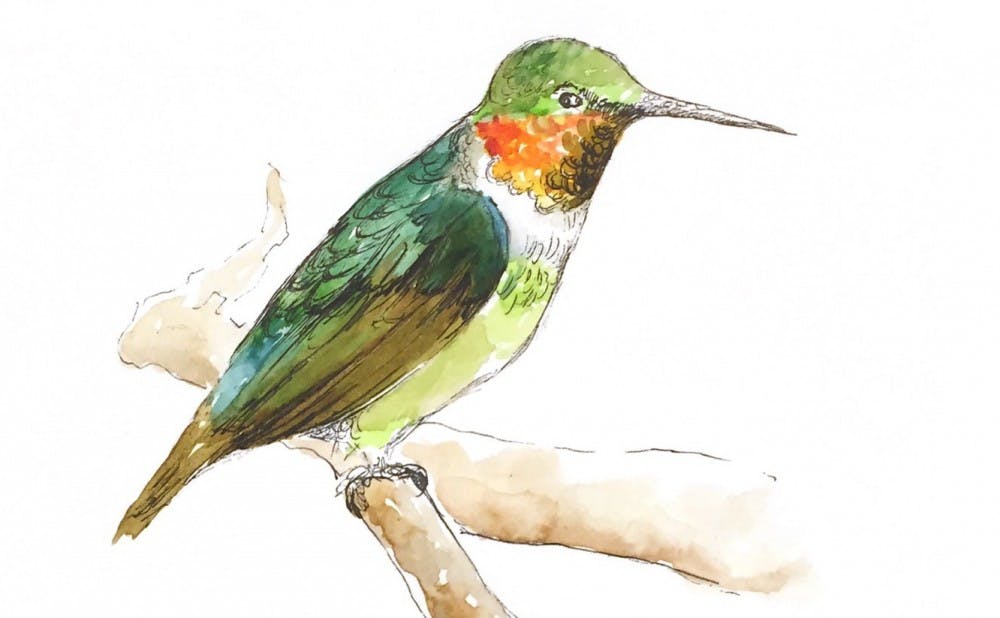Several Duke researchers spent last summer hiking through the rainforest installing camera traps to monitor hummingbirds, trying to identify the cause—and a solution—to their near extinction.
Stuart Pimm, Doris Duke professor of conservation ecology in the Nicholas School of the Environment and a specialist in present-day extinctions, leads the project. The project is also affiliated with SavingSpecies, an organization Pimm founded in 2007 to protect threatened species by collaborating with local groups to buy land and create protected areas.
Their study was featured in a recent New York Times article.
“What you see in the newspaper is just the polished, beautiful, important parts that come from hours and days and months and even sometimes years of grueling research," said junior Andrea Kolarova, who has been on the team since her first year at Duke.
During Kolarova's first summer at Duke, she conducted a meta-analysis on hummingbirds. She compiled data on hummingbird feeding behavior, geographic ranges and elevation constraints and studied with other researchers whether any or a combination of the factors are related to the birds' vulnerability to extinction.
Along with Pimm and a team of Duke students, Kolarova travelled to Colombia and Ecuador in 2017 to conduct field research on hummingbirds that would be incorporated into the meta-analysis.
They visited several reserves in the Western Andes, a biodiversity hotspot, and worked with local groups like the Hummingbird Conservancy of Colombia to study how hummingbirds feed and how that could correlate to their vulnerability to extinction.
Kolarova said she and other researchers did camera trapping and flew drones over protected and non-protected areas to carry out basic land use mapping.
Researchers went hiking with a local, who would point out the places that hummingbirds frequently fed. They then planted the camera traps, which were triggered by motion and body heat using infrared sensors.
"It seems like a super simple idea, but it is kind of revolutionary because camera trapping is a new way of studying," Kolarova said. "I mean, it's been around for decades, but it hasn’t really been used in ecological or conservation research before.”
Using camera traps allowed researchers to gather a wider variety of data than previously discovered. In previous hummingbird research studies, scientists observed an individual bush of flowers and noted the time and frequency of the birds' arrival. This method limited the overall results especially because hermit hummingbirds tend to feed on individual flowers rather than large bushes.
Pimm’s team not only observed big bushes of flowers but isolated flowers as well.
“We think that the general data that exists is skewed because of how people have been doing research in the past," Kolarova said. "This is kind of like a comparative study to see if camera trapping is going to give us a more realistic picture."
Although the the study has not concluded yet, Kolarova shared some predictions researchers have about how feeding habits could play a role in a hummingbird’s vulnerability to extinction. Hermit species feed on specific types of flowers and fly long distances to find others of the same variety. Therefore, the population of the species will be affected as the flowers become rarer due to land degradation, climate change or even people hunting them to put in museums.
Kolarova explained that the non-hermit species are not able to fly long distances and have a diversified diet, and will have to defend their territories against other competing bird species.
"They are constrained to one area," she said. "Sure, they’re able to feed on a lot of things, but because they’re social animals and they’re defensive and aggressive, they tend to be less mobile when changes occur.”
Researchers also collected elevation data because hummingbirds tend to live within different ranges.
They are concerned that as the global temperature increases, species will have to move up to remain cool, but once they reach the top of the mountain, there is nowhere else to go, putting hummingbirds at a higher risk for extinction.
Get The Chronicle straight to your inbox
Signup for our weekly newsletter. Cancel at any time.

